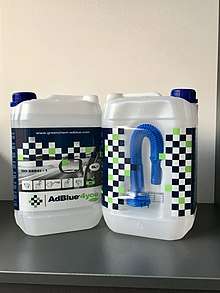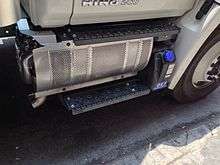Diesel exhaust fluid
Diesel exhaust fluid (DEF; also known as AUS 32 and marketed as AdBlue) is a liquid used to reduce the amount of air pollution created by a diesel engine. Specifically, DEF is an aqueous urea solution made with 32.5% urea and 67.5% deionized water. DEF is consumed in selective catalytic reduction (SCR) that lowers nitrogen oxides (NO
x) concentration in the diesel exhaust emissions from a diesel engine.[3]


Other names
In the international standard defining DEF (ISO 22241), it is referred to as AUS 32 (aqueous urea solution 32%).[4] DEF is also sold as AdBlue, a registered trademark of the German Association of the Automotive Industry.
Several brands of SCR system use DEF: BlueHDI is used by Group PSA vehicles including Peugeot, Citroen, and DS Automobiles brands; BlueTec by Daimler AG and FLENDS (Final Low Emission New Diesel System) by UD Trucks
Background
Diesel engines can be run with a lean burn air-to-fuel ratio (overstoichiometric ratio), to ensure the full combustion of soot and to prevent their exhausting unburnt fuel. The excess air necessarily leads to generation of NO
x, which are harmful pollutants, from the nitrogen in the air. SCR is used to reduce the amount of NO
x released into the atmosphere. DEF from a separate tank is injected into the exhaust pipeline. Within the SCR catalyst, the NO
x are reduced by the ammonia into water and nitrogen, which are both less polluting. The water and nitrogen are then released into the atmosphere through the exhaust.[5]
The injection rate of DEF into the exhaust depends on the specific after-treatment system, but is typically 2–6% of diesel consumption volume. This low dosing rate ensures long fluid refill intervals and minimizes the tank's size (and intrusion into vehicle packaging space). An electronic control unit adjusts the addition of fluid in accordance with such parameters as engine operating temperature and speed.
Chemistry
DEF is a 32.5% solution of urea, (NH
2)
2CO. When it is injected into the hot exhaust gas stream, the water evaporates and the urea thermally decomposes to form ammonia (NH
3) and isocyanic acid (HNCO):
- (NH
2)
2CO → NH
3 + HNCO
The isocyanic acid reacts with the water vapor and hydrolyses to carbon dioxide and ammonia:
- HNCO + H
2O → CO
2 + NH
3
Overall, thus far:
- (NH
2)
2CO + H
2O → 2 NH
3 + CO
2
Ammonia, in the presence of oxygen and a catalyst, reduces two different nitrogen oxides:[6]
The overall reduction of NO
x by urea is then:
- 2 (NH
2)
2CO + 4 NO + O
2 → 4 N
2 + 4 H
2O + 2 CO
2 and - 4 (NH
2)
2CO + 6 NO
2 → 7 N
2 + 8 H
2O + 4 CO
2
Operation in winter time
DEF freezes at −11 °C (12 °F).[7][8] For the SCR exhaust cleaning system to function at low temperatures, a sufficient amount of the frozen DEF must be melted in as short time as possible, preferably on the order of minutes. For example, 2010 EPA emissions requirements require full DEF coolant flow within 70 minutes.[9][10]
Typically, the frozen DEF is melted by heat from the engine, e.g. engine coolant passing through the DEF tank, governed by a thermostatic coolant control valve. This method may take significant time before the SCR exhaust cleaning system is fully operational, often up to an hour.[3]
Another method to thaw DEF (and thus allow for full SCR operation) is to integrate an electrical heater into the DEF tank. This heater must be sized, positioned, and powered adequately to rapidly melt sufficient frozen DEF. It should preferably be self-regulating not to overheat if (part of) the heater is outside of the liquid. It should also preferably be self-regulating to eliminate any complicated sensor and temperature regulating systems. Furthermore, the heater should not exceed 50–60 °C (122–140 °F), as DEF begins to decompose at around 60 °C (140 °F). PTC heaters are often used to achieve this.
Safety and storage
The urea solution is clear, non-toxic and safe to handle.[11] Since urea has corrosive impact on metals like Aluminium, DEF is stored and transported in special containers.[12][13] These containers are typically made of stainless steel.[13] On the other hand vehicle’s Selective catalytic reduction (SCR) systems and DEF dispensers are designed in a manner that there is no corrosive impact of urea on them.[12] It is recommended that DEF be stored in a cool, dry, and well-ventilated area that is out of direct sunlight. Bulk volumes of DEF are compatible for storage within polyethylene containers (HDPE, XLPE), fiberglass reinforced plastic (FRP), and steel tanks. DEF is also often handled in intermediate bulk containers for storage and shipping.
Diesel exhaust fluid is offered to consumers through a variety of quantities ranging from containers for single or repeated small usage, up to bulk carriers for consumers requiring a large amount of DEF. As of 2013, a number of truck stops added DEF pumps that dispense DEF. These are usually adjacent to fuel pumps so the driver can fill both tanks without moving the truck.
In Europe, increasing numbers of fuel stations offer AdBlue pumps not only for large commercial vehicles, but for passenger cars as well.
References
- "Hino Standardized SCR Unit". Hino Motors. Archived from the original on 5 August 2014. Retrieved 30 July 2014.
- "The DPR Future" (PDF). Hino Motors. Retrieved 30 July 2014.
- "What is DEF?" (PDF). Cummins Filtration.
- "ISO 22241-4:2019 Diesel engines — NOx reduction agent AUS 32". ISO (International Organization for Standardization). 2019-07-01.
- "How it works". H2Blu.
- EP 2551009, "Diesel exhaust fluid formulation having a high ammonium content and a low freezing point", published 30 January 2013
- "AdBlue What diesel vehicle owners need to know". www.rix.co.uk. Retrieved 2019-11-20.
- Panayi, Adam (2017). "Frequently Asked Questions". discoverdef.com. Retrieved 29 December 2017.
- "DEF Equipment Delivery & Storage". Cummins Inc. 2017. Retrieved 29 December 2017.
- "The 5 Facts and Fiction of Diesel Exhaust Fluid". Victory Blue - Diesel Exhaust Fluid. 2016. Archived from the original on 29 December 2017. Retrieved 29 December 2017.
- "3. Hazard Identification" (PDF). Urea Solution 32,5% Material Safety Sheet. Fertiberia. 2008-08-21. p. 2.
3.1– For Human Health … The product has a low toxicity and it is not considered that it could be harmful to health. … 3.1.5. – Long-term effects: … Urea is a substance that appears in the body as a result of proteins during metabolism, it is eliminated with the urine.
- "Urea tanks on diesel trucks -- that's the law in the United States starting in 2010". EurekAlert operated by AAAS. 10 November 2008. Retrieved 22 July 2020.
- "Urea – Krampitz storage tanks". Retrieved 22 July 2020.
External links
- VDA website entry on Adblue
- FactsAboutSCR.com North American SCR Stakeholders Group
- "AdBlue Material Safety Data Sheet" (PDF). September 2014.